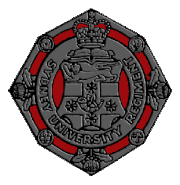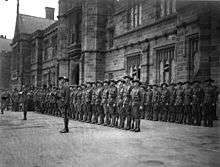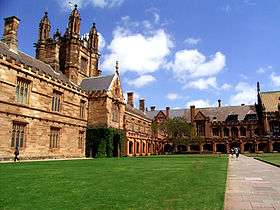Sydney University Regiment
Sydney University Regiment (SUR) is an officer-training regiment of the Australian Army Reserve. Its predecessor, the University Volunteer Rifle Corps, was raised in 1900 as a unit of the colonial New South Wales Defence Force. During the 20th century, several changes of name and role occurred. Sydney University Regiment is headquartered in Holsworthy Barracks and has detachments in Sydney, Canberra and Wollongong.
| Sydney University Regiment | |
|---|---|
 Cap badge of the Sydney University Regiment | |
| Active | 1900 – present |
| Country | |
| Branch | Army Reserve |
| Type | Officer Training |
| Role | Army Reserve Officer Training |
| Size | Regiment |
| Part of | 8 Brigade |
| Garrison/HQ | Sydney (Holsworthy) |
| Colours | Blue & Gold and Black & Red |
| March | Men of Harlech |
| Anniversaries | 17 November 1900 |
| Commanders | |
| Honorary Colonel | General David Hurley |
| Insignia | |
| Unit Colour Patch | |
History
Early years
The University Volunteer Rifle Corps (UVRC) was raised on 17 November 1900, as part of the colonial military forces of New South Wales. The University of Sydney was the colony's only university at the time, and two of its professors, T. W. Edgeworth-David and J. T. Wilson. VD, a former officer of the East Surrey Regiment, and employed as a teacher of physics at the university, encouraged the formation of a volunteer military unit.
Military training commenced in early 1901 with one hundred volunteers. The volunteers held their first parade in uniform later that year, when visited by the Duke of York, later to become George V. The UVRC appeared in public for the first time at a review ceremony in Centennial Park on the occasion of the coronation of Edward VII.
In 1903, the UVRC changed its name to the Sydney University Scouts (SUS) and the establishment had by then doubled to two rifle companies. When "universal" boyhood conscription was introduced in 1911, the Scouts' numbers increased, since all eligible undergraduates of the university were drafted into it[1] and it became a militia battalion. At this time it also became responsible for the training of boy soldiers, the forerunner of today's Australian Cadet Corps, during their attendance at camps.
World War I
On the outbreak of the World War I, over sixty percent of the Scouts enlisted in the Australian Imperial Force (AIF). Members of the Scouts served widely within the AIF. In mid-1918 a university company was recruited from students at the University of Sydney for active service in the AIF. The war ended before it mobilised for service.
1920s

A regimental band of pipes and drums was formed in 1925. In 1927 the University Scouts were renamed the Sydney University Regiment (SUR). In recognition of its members' service in the Great War, Lieutenant-General Sir Harry Chauvel presented the regiment with its first King's and regimental colours. A display was presented by the regiment's artillery unit.[1]
In 1929, King George V approved the SUR's affiliation with the 60th Regiment, The King's Royal Rifle Corps (KRRC) and consequently the regiment's embellishments and badges of rank became black with a red felt backing. These distinctive arrangements continue and are unique in the Australian Army. This alliance was maintained with The Royal Green Jackets of the British Army, the successor regiment to the KRRC until its amalgamation.
World War II
The regiment per se was not mobilised; but, as in the World War I, many serving and former members of the SUR enlisted in the Second AIF and served with distinction in all theatres of war. A notable example was Sir Arthur Roden Cutler, who had enlisted in the SUR Transport Platoon in 1936. He enlisted in the Second AIF and was awarded the Victoria Cross on 28 November 1941 "for most conspicuous and sustained gallantry, and for outstanding bravery from 19th June to 16th July in Syria."
Two other officers, Brigadier (later, Major General Sir) Victor Windeyer and Brigadier (later, Major General Sir) Ivan Dougherty distinguished themselves in battalion and brigade commands in the Near-East and the Pacific, prior to returning successfully to civilian life.
1960s
In 1960, the regiment's campus HQ was destroyed by fire. (The regiment was subsequently rehoused at a new facility on university-owned land at Darlington.)[2]
National Service (conscription of 20-year-olds by ballot) was introduced by the Menzies government in November 1964 and operated until December 1972. During this period, the regiment provided an alternative form of military service for university students. SUR during this period consisted of four rifle companies, a recruit-training company and an HQ and support company. The support company provided mortar, signal, pioneer and transport platoons. This was a period of increasing student activism and, in particular, protests against conscription and Australia's participation in the Vietnam War. In May 1969, protesting students confronted a guard of honour for Sir Roden Cutler VC, who was honorary colonel of the regiment and governor of NSW.
1990s
The regiment received new colours in 1994, from the state governor, Rear Admiral Peter Sinclair. In 1997, the regiment came under command of the Royal Military College, Duntroon, tasked with conducting training that prepares part-time officer cadets for their final attendance at the college.[2]
Today
The regiment now provides a series of training block (TB) courses in order to qualify officer cadets to graduate from the Royal Military College - Duntroon as a Lieutenant in the Australian Army Reserve. An officer cadet must complete a total of five training blocks in order to graduate:
- TB1 - Officer Cadets complete the Army Reserve Recruit course run at 1 Recruit Training Battalion (1 RTB) located at Kapooka which lasts 35 days. 1 RTB provides basic soldier training to all new members of the Australian Army, both regular and reserve. TB1 teaches cadets a range of skills including drill, weapons handling, Army Combatives, military tradition and field skills. Officer Cadets need to complete this course within the first 12 months of enlistment so should ensure they are able to get the time away from studies or work.
Upcoming TB1 courses are on 30 Oct - 05 Dec 2020; 15 Jan - 20 Feb 2021; 02 April - 08 May 2021 and 14 May - 19 June 2021
- TB2 - TB2 runs for 16 days and builds on the skills learnt from recruit training to provide officer cadets with the skills, knowledge and attributes required to operate as part of a section. This course teaches section formations, drills and tactics which are then practiced in the field.
- TB3 - This 16 day course trains and tests officer cadets to lead soldiers at the section commander level. Training includes the preparation and delivery of orders, military planning, ethics and tactical theories for combat. Officer cadets then deploy to the field where they are assessed at their first level of leadership.
- TB4 - The focus of this training block is to train officer cadets to lead a platoon and introduces them to command at a platoon level. Officer cadets will undertake more advanced training in military planning and tactics. Platoon formations, drills and procedures will be taught and practiced in the field.
- TB5 - The final training block is undertaken at the Royal Military College - Duntroon. This TB provides the final training and assessment and if successful officer cadets will be commissioned as a Lieutenant in the Australian Army Reserve at the conclusion of the course. This course runs for approximately 23 days and will teach officer cadets more advanced military planning and tactics including how to conduct platoon defence and attack. A large proportion of this course is conducted in the field assessing officer cadets as platoon commanders.
In between training blocks officer cadets will undertake a range of other training run on Tuesday night's (1900-2200hrs) and over weekends. Officer cadets are also required to undertake fitness training in their personal time to meet the conditioning required for military courses.
Army Reserve Officer GAP year Program Sydney University Regiment provides the opportunity for civilians to elect to undertake their Army Reserve Officer Training within a one-year time frame. Participants undertake the above training block modules in close succession and then after graduation as a Lieutenant will move into an allocated Australian Regular Army Unit for the remainder of a year long full-time contract. During this time they will be provided with exposure to a range of military experiences that will enhance their future Army Reserve Service. At the conclusion of the one-year period participants will be fully qualified and posted to an Army Reserve unit.
During the one-year contract period participants will be eligible for all pay and conditions as per a member of the Australian Regular Army including accommodation and free medical/dental treatment.
Notable graduates
- Political
- The Hon. Gough Whitlam, AC, QC
- The Hon. John Aquilina, AM
- Military
- Major General The Rt. Hon. Sir Victor Windeyer, KBE, CB, DSO & Bar, ED, QC
- Major General Sir Ivan Dougherty, CBE, DSO & Bar, ED
- Major General John Broadbent, CBE, DSO, ED
- Major General Paul Cullen, AC, CBE, DSO & Bar, ED
- Major General The Hon. Paul Brereton, AM, RFD
- Brigadier Sir Frederick Chilton, CBE, DSO & Bar
- Brigadier The Hon. Max Willis, RFD, ED
- Captain The Hon. Peter Collins, AM, RFD, QC, RANR
- Professor Major Errol Solomon Meyers
- Lieutenant Sir Roden Cutler, VC, AK, KCMG, KCVO, CBE
- Other
- Sir Douglas Mawson, OBE, FRS, FAA
- Sir Errol Know, MBE
- Alexander Boden, AO, FAA
- Justice Roderick Howie, QC
- W A (Tiger) O'Reilly
See also
- Officers' Training Corps (UK equivalent)
- Reserve Officers' Training Corps (US equivalent)
Notes
- University Regiment : Colours presented : Artillery display Sydney Morning Herald 12 September 1927, at Trove
- Sydney University Regiment Presentation of the Queen's and Regimental Colours Historical exposition at Regimental Books website. Accessed 27 May 2012
References
- ASIO brief for Prime Minister, Appendix C to minute on "Demonstrations", 13 May 1969, PMD file 69/1407, CRS A463/36, AA.
- Chapman, Ivan.(1996). Sydney University Regiment: The First 80 Years. Self-published. OCLC 223331199.
- Dart, JR. "Student Protest and the Sydney University Regiment", Australian Infantry 16/1 (1970): 16–17.
- Lilley, Alan Bruce. Sydney University Regiment: a description of the insignia worn from 1900–1973 by military units at the University of Sydney, together with information on honorary colonels and commanding officers. Military Historical Society of Australia, 1974.
- A history of the pipes and drums of the Sydney University Regiment. Sydney University Regiment Historical Society, 1977. ISBN 0-9596352-0-3
